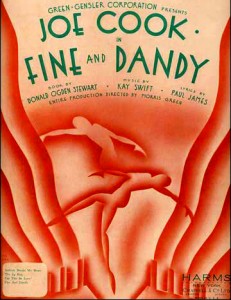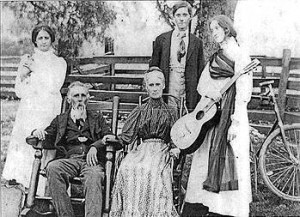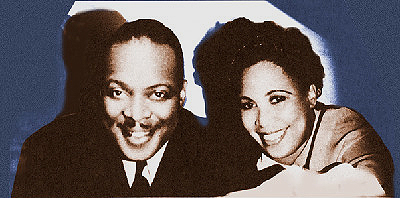What do Kay Swift, Ella Fitzgerald and the Sisters of Happy Hollow have in common? These women composed hit songs that became jazz standards. They aren't all First Ladies of Jazz, for some, 'ladies in waiting' might be a better description. But they did have a hand in composing songs that endured in jazz for decades, from a Gibson Girl of a waltz to a rhythm and blues chart-topper that paved the way for the rock and roll revolution.
These women of song had an ear for melody and a uniquely feminine way with words. Sometimes their songs conveyed a yearning for romance—and in others, a sassy, finger-shaking blues.
Growing up in rural Tennessee Beth Slater Whitson and her sister Alice started writing poetry as soon as they could spell. The Sisters of Happy Hollow churned out hundreds of song lyrics and poems. Whitson had her first hit in a 1909 collaboration with composer Leo Friedman. The sheet music for "Meet Me Tonight in Dreamland" was an overnight success in parlors across the country.
How did this gentle waltz find its way into the Jazz Age? Guitarist Eddie Condon’s 1938 recording with His Windy City Seven is the definitive hot jazz rendition of Beth Slater Whitson’s turn-of-the-century waltz. But Condon recalled performing this tune in the early 1920s as a young musician with Peavey’s Jazz Bandits, knocking around the Midwest playing dance hall jobs.
One Sunday morning the band showed up for an audition with a new booking agent at his St. Paul home. Asked to play "Meet Me Tonight Dreamland," they banged out an up-tempo hot jazz version. Nobody played the melody, and in the middle of a placid Sunday morning it sounded like judgment day was at hand. When it was over the agent whispered to Peavey, “That was nice but—now could you play something soft and slow, something like, 'Meet Me Tonight In Dreamland'?"
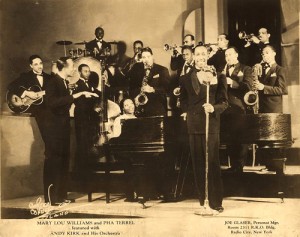
Andy Kirk’s Twelve Clouds of Joy. Photo courtesy University Missouri, Kansas City Miller Nichols Library.
If some songs have legs, Alberta Nichols' composition "Until the Real Thing Comes Along" was a real globetrotter. In 1931. Alberta and her husband Mann Holiner wrote the number on commission for Ethel Waters, who was starring in a show called Rhapsody in Black. Time magazine ran a savage review of the show, but that didn't stop their song. A couple years later when a touring company of Rhapsody in Black played Kansas City's Schubert Theater, a popular local group, the Three Chocolate Drops, heard the song and made it their own. "Until the Real Thing Comes Along" became a favorite on the K.C. music scene.
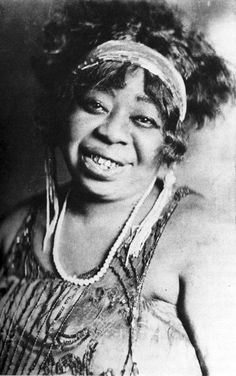
Blues Queen Ma Rainey. Photo courtesy Red Hot Jazz.
Fast forward to 1935. With a freshly inked Decca Records contract in his pocket, it was natural for Kansas City bandleader Andy Kirk and his Twelve Clouds of Joy to choose "The Real Thing" for their first recording. Their version, with a vocal by high tenor Pha Terrell, put the band and Kansas City in the national spotlight. But it still wasn't over for Alberta Nichols' tune. In 1942 Nichols' and Mann's old friend Billie Holiday recorded a version of "Until the Real Thing Comes Along" that is frequently heard today.
Gertrude "Ma" Rainey was no beauty and she was a strong-willed businesswoman, but onstage she could charm even the roustabouts who did the heavy lifting in her traveling tent show through the Deep South. Billed as the “greatest colored show on earth," the Rabbit Foot Minstrels promised "everything clean, moral and refined." Late at night Ma Rainey took the stage and belted out numbers she composed, like "See See Rider"—a popular blues standard a hundred years later.
The phrase "tough act to follow" takes on new meaning for female vocalists in the wake of Billie Holiday. But that's just what Helen Humes did in 1937 when she joined Count Basie's band after Billie Holiday left to join Artie Shaw. Touring with Basie for three years and sharing the bandstand with blues belter Jimmy Rushing, Humes earned a national reputation. Then in the early 40s she headed west to Los Angeles and made a switch from balladeer to pioneering R&B singer. One sultry night in the summer of 1950, at the Shrine Auditorium, Humes belted out her new song—a playful praise of 'gold-digging' called "Million Dollar Secret."
Ella Fitzgerald's knees were knocking with fear as she waited in the wings at the Apollo Theater to perform the number she'd been rehearsing for a coveted amateur hour slot. She could hear the crowd cheering for the Edwards sisters, "the dancingest girls around" as Ella put it. She knew she could never follow that act. She was just not that good a dancer. Thanks to the intimidating Edwards sisters, at the last moment, Ella Fitzgerald made her Apollo debut as a singer. Four years later in 1938 she had her first big song. It was a playful version of the 19th century nursery rhyme, "A-Tisket, A-Tasket." The record sold a million copies, spent seventeen weeks on the pop charts, and Ella Fitzgerald's swinging re-invention of a poem for children became a jazz classic.
This week on Riverwalk Jazz, vocalists Topsy Chapman, Carol Woods, Stephanie Nakasian and Becky Kilgore join The Jim Cullum Jazz Band for A Woman's Touch, a concert of jazz standards composed by women.
Photo credit for Home Page: Composer Kay Swift. Property of Kay Swift Trust.
Text based on Riverwalk Jazz script by Margaret Moos Pick© 2011


